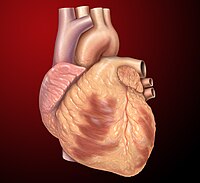
Photo from wikipedia
Successful treatment of cancer can be hampered by the attendant risk of cardiotoxicity, manifesting as cardiomyopathy, left ventricle systolic dysfunction and, in some cases, heart failure. This risk can be… Click to show full abstract
Successful treatment of cancer can be hampered by the attendant risk of cardiotoxicity, manifesting as cardiomyopathy, left ventricle systolic dysfunction and, in some cases, heart failure. This risk can be mitigated if the injury to the heart is detected before the onset to irreversible cardiac impairment. The gold standard for cardiac imaging in cardio-oncology is echocardiography. Despite improvements in the application of this modality, it is not typically sensitive to sub-clinical or early-stage dysfunction. We identify in this review some emerging tracers for detecting incipient cardiotoxicity by positron emission tomography (PET). Vectors labeled with positron-emitting radionuclides (e.g., carbon-11, fluorine-18, gallium-68) are now available to study cardiac function, metabolism, and tissue repair in preclinical models. Many of these probes are highly sensitive to early damage, thereby potentially addressing the limitations of current imaging approaches, and show promise in preliminary clinical evaluations. The overlapping pathophysiology between cardiotoxicity and heart failure significantly expands the number of imaging tools available to cardio-oncology. This is highlighted by the emergence of radiolabeled probes targeting fibroblast activation protein (FAP) for sensitive detection of dysregulated healing process that underpins adverse cardiac remodeling. The growth of PET scanner technology also creates an opportunity for a renaissance in metabolic imaging in cardio-oncology research.
Journal Title: Current Cardiology Reports
Year Published: 2022
Link to full text (if available)
Share on Social Media: Sign Up to like & get
recommendations!